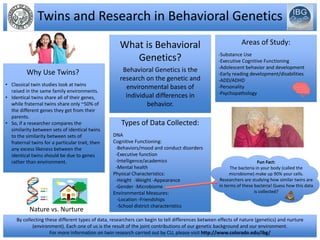031016Presentation_Twins_in_Research_FINAL_no_notes
•Download as PPTX, PDF•
0 likes•69 views
Classical twin studies compare identical twins, who share all genes, to fraternal twins, who share about half. This allows researchers to distinguish the effects of genes versus environment on traits. Researchers collect DNA data, measures of cognitive and physical characteristics, and environmental factors from twins. They study topics like substance use, executive function, adolescent development, and psychopathology to understand the relative contributions of nature and nurture.
Report
Share
Report
Share

Recommended
Introductory Psychology: Behavior Genetics

lecture 10 from a college level introduction to psychology course taught Fall 2011 by Brian J. Piper, Ph.D. (psy391@gmail.com) at Willamette University,
Actividad 8 grupo 4 kelly vidal

Aproximación contextual de una experiencia pedagógica en el aula para fortalecer el pensamiento numérico
Recommended
Introductory Psychology: Behavior Genetics

lecture 10 from a college level introduction to psychology course taught Fall 2011 by Brian J. Piper, Ph.D. (psy391@gmail.com) at Willamette University,
Actividad 8 grupo 4 kelly vidal

Aproximación contextual de una experiencia pedagógica en el aula para fortalecer el pensamiento numérico
Using the Iridium Satellite Network to Protect Wildland Firefighters

A comprehensive, web-based wildland fire incident management program that includes a real-time GPS tracking system and complete online fillable ICS forms for NIMS reporting.
Some R Examples[R table and Graphics] -Advanced Data Visualization in R (Some...![Some R Examples[R table and Graphics] -Advanced Data Visualization in R (Some...](data:image/gif;base64,R0lGODlhAQABAIAAAAAAAP///yH5BAEAAAAALAAAAAABAAEAAAIBRAA7)
![Some R Examples[R table and Graphics] -Advanced Data Visualization in R (Some...](data:image/gif;base64,R0lGODlhAQABAIAAAAAAAP///yH5BAEAAAAALAAAAAABAAEAAAIBRAA7)
Some R Examples[R table and Graphics]
Advanced Data Visualization in R (Some Examples)
References:
http://zevross.com/blog/2014/08/04/beautiful-plotting-in-r-a-ggplot2-cheatsheet-3/
http://www.cookbook-r.com/
http://moderndata.plot.ly/trisurf-plots-in-r-using-plotly/
I hope that it would ne useful for UseRs.
Umarım; R programı ile ilgilenen herkes için yararlı olur.
Volkan OBAN
The Biological approach

AS Psychology Unit 2
Edexcel
Summarised notes on Twin and Adoption Studies, PET and MRI Scans in AS Psychology - types of methodology in Unit 2 Chapter 4 of AS Psychology.
Genetics of personality

This presentation is about the interaction between genes and environment in personality
Heredity _environment_interaction

Heredity & Environment interaction in personality of individuals- For PSYCHOLOGY STUDENTS
More Related Content
Viewers also liked
Using the Iridium Satellite Network to Protect Wildland Firefighters

A comprehensive, web-based wildland fire incident management program that includes a real-time GPS tracking system and complete online fillable ICS forms for NIMS reporting.
Some R Examples[R table and Graphics] -Advanced Data Visualization in R (Some...![Some R Examples[R table and Graphics] -Advanced Data Visualization in R (Some...](data:image/gif;base64,R0lGODlhAQABAIAAAAAAAP///yH5BAEAAAAALAAAAAABAAEAAAIBRAA7)
![Some R Examples[R table and Graphics] -Advanced Data Visualization in R (Some...](data:image/gif;base64,R0lGODlhAQABAIAAAAAAAP///yH5BAEAAAAALAAAAAABAAEAAAIBRAA7)
Some R Examples[R table and Graphics]
Advanced Data Visualization in R (Some Examples)
References:
http://zevross.com/blog/2014/08/04/beautiful-plotting-in-r-a-ggplot2-cheatsheet-3/
http://www.cookbook-r.com/
http://moderndata.plot.ly/trisurf-plots-in-r-using-plotly/
I hope that it would ne useful for UseRs.
Umarım; R programı ile ilgilenen herkes için yararlı olur.
Volkan OBAN
Viewers also liked (14)
Using the Iridium Satellite Network to Protect Wildland Firefighters

Using the Iridium Satellite Network to Protect Wildland Firefighters
Some R Examples[R table and Graphics] -Advanced Data Visualization in R (Some...![Some R Examples[R table and Graphics] -Advanced Data Visualization in R (Some...](data:image/gif;base64,R0lGODlhAQABAIAAAAAAAP///yH5BAEAAAAALAAAAAABAAEAAAIBRAA7)
![Some R Examples[R table and Graphics] -Advanced Data Visualization in R (Some...](data:image/gif;base64,R0lGODlhAQABAIAAAAAAAP///yH5BAEAAAAALAAAAAABAAEAAAIBRAA7)
Some R Examples[R table and Graphics] -Advanced Data Visualization in R (Some...
Similar to 031016Presentation_Twins_in_Research_FINAL_no_notes
The Biological approach

AS Psychology Unit 2
Edexcel
Summarised notes on Twin and Adoption Studies, PET and MRI Scans in AS Psychology - types of methodology in Unit 2 Chapter 4 of AS Psychology.
Genetics of personality

This presentation is about the interaction between genes and environment in personality
Heredity _environment_interaction

Heredity & Environment interaction in personality of individuals- For PSYCHOLOGY STUDENTS
HEREDITY & ENVIRONMENT - Psychology .pptx

HEREDITY & ENVIRONMENT - Psychology
For Physiotherapy and Nursing students
Similar to 031016Presentation_Twins_in_Research_FINAL_no_notes (20)
031016Presentation_Twins_in_Research_FINAL_no_notes
- 1. Twins and Research in Behavioral Genetics What is Behavioral Genetics? Behavioral Genetics is the research on the genetic and environmental bases of individual differences in behavior. Why Use Twins? • Classical twin studies look at twins raised in the same family environments. • Identical twins share all of their genes, while fraternal twins share only ~50% of the different genes they get from their parents. • So, if a researcher compares the similarity between sets of identical twins to the similarity between sets of fraternal twins for a particular trait, then any excess likeness between the identical twins should be due to genes rather than environment. Types of Data Collected: DNA Cognitive Functioning: -Behaviors/mood and conduct disorders -Executive function -Intelligence/academics -Mental health Physical Characteristics: -Height -Weight -Appearance -Gender -Microbiome Environmental Measures: -Location -Friendships -School district characteristics Areas of Study: -Substance Use -Executive Cognitive Functioning -Adolescent behavior and development -Early reading development/disabilities -ADD/ADHD -Personality -Psychopathology By collecting these different types of data, researchers can begin to tell differences between effects of nature (genetics) and nurture (environment). Each one of us is the result of the joint contributions of our genetic background and our environment. For more information on twin research carried out by CU, please visit http://www.colorado.edu/ibg/ Fun Fact: The bacteria in your body (called the microbiome) make up 90% your cells. Researchers are studying how similar twins are in terms of these bacteria! Guess how this data is collected? Nature vs. Nurture